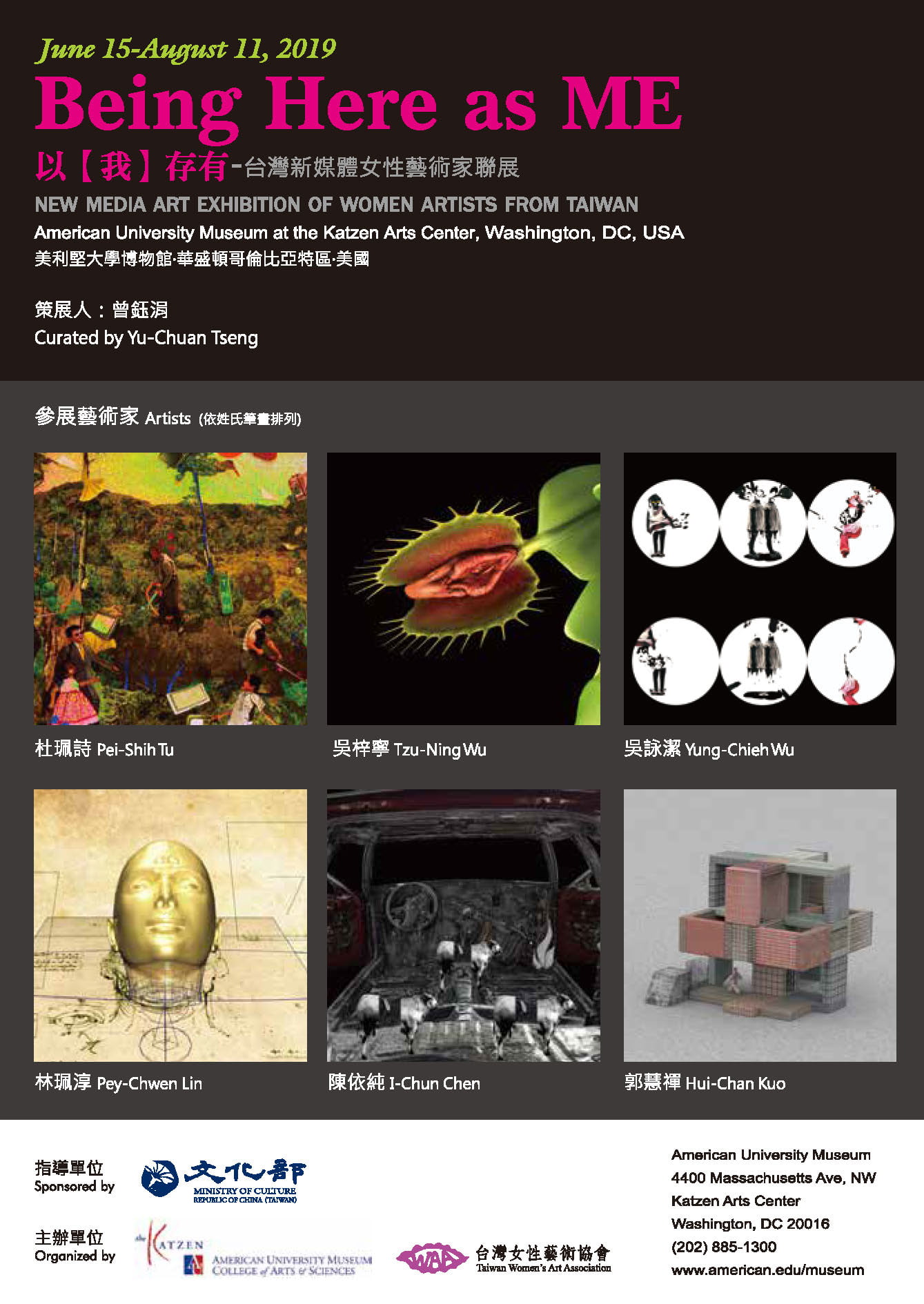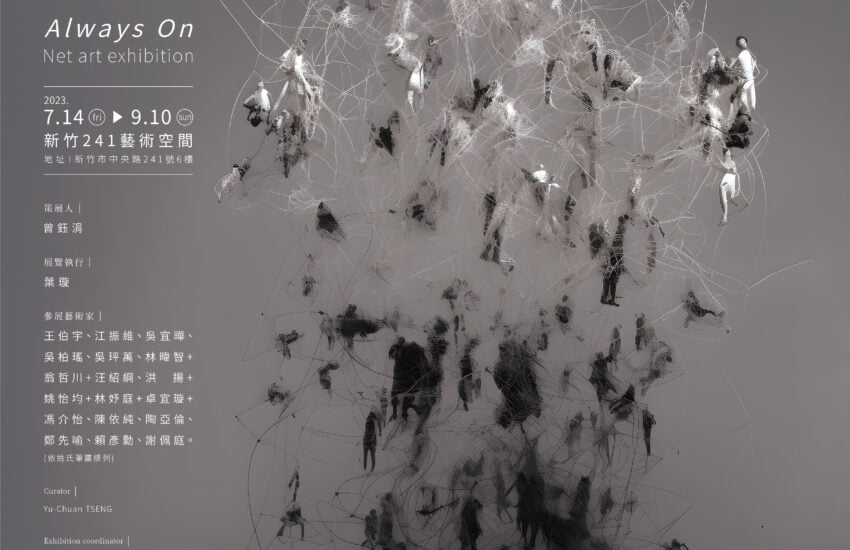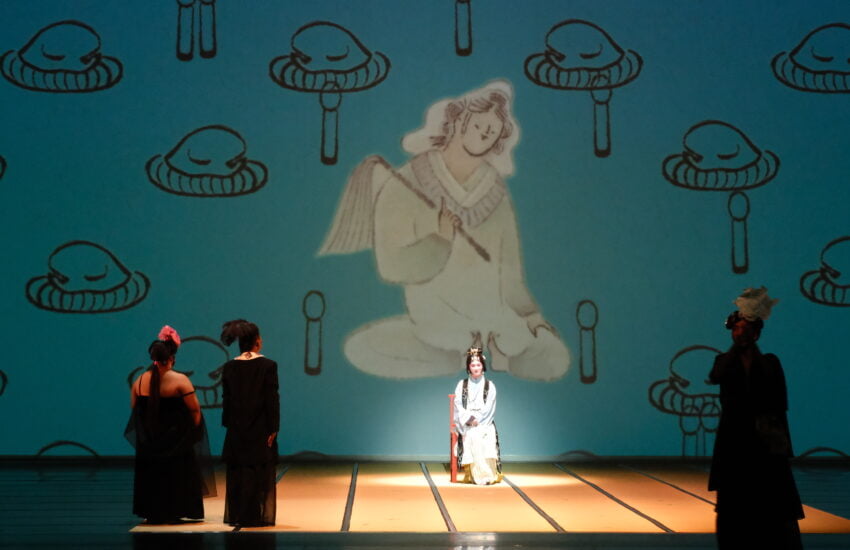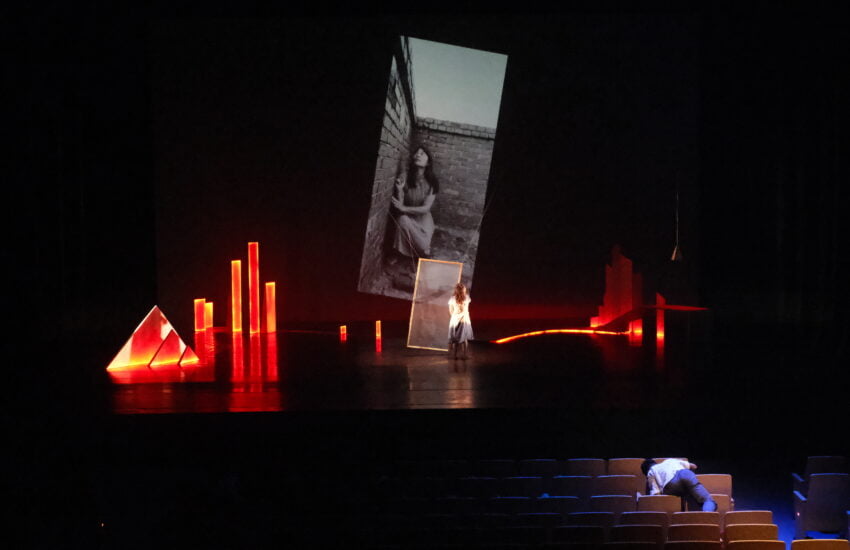Being Here as ME: New Media Art Exhibition of Women Artists from Taiwan
Curated by Yu-Chuan Tseng
Related events
Summer Opening Reception
Saturday, June 15, 2019, 6:00 p.m.
free and open to all
Gallery Talk: Being Here as ME
Monday, June 17, 2019, 12:00-2:00 p.m.
free and open to all, please RSVP to museum@american.edu
Related Website: https://www.american.edu/cas/museum/2019/Being-Here-as-ME.cfm
Exhibition Date: June15-August 11, 2019.
Address: 4400 Massachusetts Ave., NW, Washington, D.C. 20016
Contemporary women’s art in Taiwan has continued to develop since the early 1980s. It exhibits an independent and complete pedigree of contemporary trends. Beginning in the 1980s, emerging ideas of globalization, modernism, and feminism made a great impact and sparked inspiration in Taiwanese arts and culture. In 1987, when Taiwan’s martial law was lifted, various women’s rights groups were established. The efforts of these feminist organizations enriched the vision and content of Taiwanese women’s art. Their creative styles gradually diversified, and women artists began to explore the female consciousness as a primary topic. In the 1990s, a group of Taiwanese women artists who had studied abroad returned to Taiwan. They promoted female sovereignty through artworks, lectures, and book translations. Through workshops and social engagement projects, they criticized the social system, then dominated by male hegemony and gender discrimination. Pioneers among Taiwanese women artists established the Taiwan Women’s Art Association, which exists to the present day. The Association is still the most important group of women artists in Taiwan.
Since the 2000s, the liberation of gender consciousness and the development of women’s art has accumulated a great deal of energy. The creative efforts and actions of women artists have increasingly become livelier and more diverse. For the younger generation, the predicament of gender discrimination is no longer obvious. The popularity of new media technology provides artists with new tools of creation and new topics of concern. Their work transcends gender discussions, and through social strategies, action, and engagement they express their concerns and create artworks revealing their anxiety and opinions about the ecology of society, science, technology, and the environment.
Science and Technology
In the Book of Genesis in the Hebrew Bible, Eve was created by God. In the work of Pey-Chwen Lin, Eve is a clone figure created by biotechnology. The project combines the Vitruvian Man (c. 1490) drawings by Leonardo da Vinci (1452-1519) with each stage in the development of Eve Clone. Pey-Chwen Lin creates an idealistic, beautiful female figure to show the greedy desire of human beings conducting eugenic gene experiments, those intent on playing the role of God. The Making of Eve Clone Project shows the process of making, while Making of Eve Clone Documentation is the verification of making. Made through Augmented Reality applications and shown on an iPad, the audience can review the documentation vividly. In The Birth of Eve Clone, rotations of each angle of the body, the wire frame, skeleton, and the engraving pattern show how Eve Clone has been shaped in the creation process.
Tzu-Ning Wu created three projects to present her science fiction story by way of simulated advertisements: GFP Self-cultivating Instructions, GFP Lab, and The Post-Venus Flytrap Project 01. Self-cultivating tells the science fiction story of the Laboratory of the GFP (Good Food Provider). In the videos, Tzu-Ning Wu teaches the audience how to use equipment to cultivate the food he/she needs for their own body in an ambiguous, imaginative space with a fluorescent aura. The Post-Venus Flytrap Project 01 shows a simulated plant which modifies a Venus flytrap (Dionaea muscipula) into a woman’s labia. The simulation of biological gene blending and artificial organ transplantation suggests the possibility of nutritional acquisition and foraging in the future.
I-Chun Chen shows an electronic world run by humanoid robots, where human beings are extinct. In the way of dynamic science fiction comics: Little Black’s Whole Life in the Factory – First Episode and Do You Dream of Electric Sheep?, I-Chun Chen shows the ridiculous state of the electronic age. These dog-headed robots evolved from humans, wear uniforms, and work hard to maintain the function of the world and gain their own gas rationing. They are not allowed to realize that they are human, or else will be destroyed. Day to day, the earth is largely run by Androids. I-Chun Chen asks us, “do Androids Dream of Electric Sheep?” borrowing the concept of the fiction novel by American writer Philip K. Dick, first published in 1968 Do Androids Dream of Electric Sheep?. She proposes that human beings have become robots. The “Black dog” is a metaphor for human beings who have gradually lost their ability to think, and are driven by the social and digital system.
Pey-Chwen Lin, Tzu-Ning Wu, and I-Chun Chen bring to light the ethical issues behind the dazzling glamour of science and technology. They employ fictional stories and create astonishing animations as a strategy to warn human being. When humans hold the power of science and technology to determine and change life forms, to develop artificial intelligence machines endlessly, and to ignore digital infiltration and control, human beings may become God.
Society, Systems, and Politics
In Taiwan there has been a state of uneasiness and turmoil due to the political, social, and gender issues present in the republic. Woman artists explore these issues with a critical view. They examine the relationship of humans to the environment, and sneer at the dilemma. They recall historical moments of political tragedy, and are concerned about the memory of the old times.
In the series Lock and Amusement Field created by Hui-Chan Kuo, the Cube Men, which symbolize humanity itself, are walking in mazes. The mazes consist of the various shapes of the [China Game Lock] whose surface textures are images collected from local places where Hui-Chan Kuo used to live. These locks are separated and composed automatically to form the mazes and become the playground of Cube Men. The continually walking cube men represent mankind. As humans, we try to survive and find the right routes in different environments and systems. Hui-Chan Kuo uses the puzzle lock toys cube game to describe the game of life.
As a mother and daughter, Yung-Chieh Wu uses images from her childhood photos as a topic. In the black humor animation The incantation of the little one-Alas!!, she cuts off and separates the head and body of the self. A mutilated body that constantly splashes black juice does not evoke annoyance, but rather humor. In the photo, the military residence where she lived in her childhood was torn down and became a field of weeds. The original purpose of the military residence was to serve as provisional housing for soldiers of the ROC armed forces and their families from mainland China after the Kuomintang (KMT) retreated to Taiwan. The houses in these villages were often haphazardly and poorly constructed, having been built hastily with limited funding. Currently, there is a debate about dismantling or preserving them for their land value or cultural memory. Yung-Chieh Wu printed the photos and created the frame from a container using paper tape. The paper tape sticks together and the patches represent a specific period of time.
In her animations, Pei-Shih Tu creates a series and a serious story with the title Mount Yu: The Adventures in Mount Yu I, The Adventures in Mount Yu lll and The Adventures in Mount Yu V (From Michel Foucault to Our Glorious Future). Mount Yu (in Chinese, the meaning of Yu is Jade) is not only the highest mountain but also an important symbol in Taiwan. Its image is engrained in the minds of every person living there, making it an iconic image. The animations interpret the vain struggles of various social activists, events, arguments, and historical tragedies which happened in Taiwan’s history. Pei-Shih Tu pieces together historical images gathered from the internet to show her observation that history is an illusion created through an amalgamation of knowledge fragments. In Mount Yu, people live in and enjoy life under an extremely totalitarian system. They eat, drink, have sex, and watch TV. They are brainwashed and forget the tragic lessons of the past.
To be Continued
“Creation” involves psychological need and self-expectation. Adopting the female gaze to examine the existing social system and our present concerns about the environment, contemporary women artists pull together family, children, art, and work. Through this breakthrough in Taiwan’s social system and beyond stereotypes of gender, an expectation of the self is reconstructed through vocabulary and an exposition of women’s art. The title Being here as ME highlights the determination of women artists in Taiwan and how they strive towards constructions of female subjectivity. These female artists, Pey-Chwen Lin, Tzu-Ning Wu, Yung-Chieh Wu, I-Chun Chen, Pei-Shih Tu, and Hui-Chan Kuo, are invited to show their consciousness of biotechnology, digital existence, social systems, and political critiques.
The creativity of these women artists, and their intention of provoking viewers to face the truth about social and technological problems brews a powerful energy. This is much like the goddess NuWa who took part in the creation of heaven and earth in Chinese mythology. When the heavens collapsed, she demonstrated the great power of women by showing compassion and using colorful melted rock to patch the holes in the sky. Female artists, with social consciousness, are trying to call attention through the power of art, and trying to awaken solicitude in human beings.



